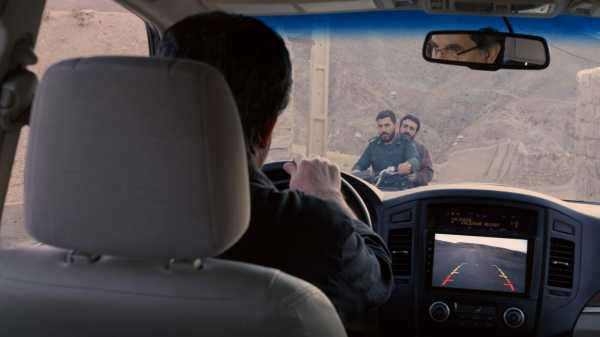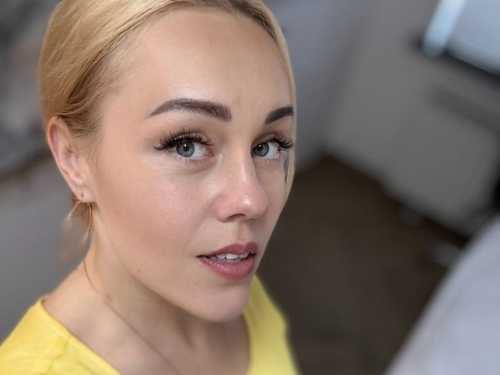
The films that the Iranian director Jafar Panahi has made since 2011 are exemplary works of personal cinema. He plays the lead role in all of them, as himself, and he often puts his own filmmaking practices on display in them. For exactly this reason, they’re also major works of political cinema: after his arrest and conviction on political charges, in 2010, he was sentenced to a twenty-year ban on making films and giving interviews, and was also placed under house arrest. Nonetheless, Panahi continued to clandestinely make films (such as “This Is Not a Film,” “Taxi,” and the short “Life”), even travelling within Iran to do so, and they’re among the best movies of the past decade. Panahi’s most recent feature, “No Bears” (screening at the New York Film Festival on October 9th, 13th, and 14th), is fully their equal—it even exceeds them in important ways. As of this writing, Panahi is in prison; after his conviction, he was also given a six-year prison sentence, which was subsequently suspended. In July of this year, between the time of the film’s completion and its première at the Venice Film Festival, Panahi was arrested, while protesting the arrest of two other filmmakers, Mohammad Rasoulof and Mostafa Aleahmad, and was ordered to serve his prison sentence. “No Bears” dares to confront the political repression, the ambience of fear, that pervades Iran. It also lays bare the endemic social underpinnings of the country’s repressive regime.
“No Bears” is a film of rage calmly expressed, and the target of that rage is religious dogma—in particular, the part of it that subordinates women to the will of men. It’s also a film about filmmaking that includes an elaborate film-within-a-film and an even more elaborate drama involving its production. In “No Bears,” Jafar (played by the director) has settled into a hilly rural village near the border with Turkey, because a small Turkish city just across the border is the location for the film that Jafar is shooting. (I’ll uneasily refer to the character as Jafar and the real-life filmmaker as Panahi, even if, of course, the movie is built around the very effacement of that distinction.) He can’t go there, but, rather, is directing remotely—something that he could do as easily from his home in Tehran (even more easily, because in the city the Internet connection is solid; in the village, it’s a constant problem). But he wants to be near the action, even if he can’t be a physical part of it. Jafar rents a room from a villager named Ghanbar (Vahid Mobaseri), whose elderly mother (Narjes Delaram) dotes on the filmmaker, and he takes an interest in the life of the village, photographing its residents.
There’s a romantic drama brewing in the village, and Jafar quickly finds himself in the middle of it. A rumor that he may have photographed an illicit couple sparks a major brouhaha, in which local tradition, political authority, and religious practice intertwine to cast suspicion on Jafar and to give rise to tense gatherings and extended negotiations of increasingly grave consequence to him, to the villagers, and, especially, to the young lovers at the center of the crisis. Meanwhile, there’s also a romantic drama taking place across the border in Turkey, regarding the fictional film that Jafar is directing remotely; that film tells the story of a nearly middle-aged Iranian couple, Zara (Mina Kavani) and Bakhtiar (Bakhtiar Panjei), who have long been living in Turkey as refugees while trying to find a way to get to Europe. In Jafar’s film, Zara gives explicit voice to her life as an exile, citing her imprisonment and torture in Iran, even as such menaces loom over Jafar—over Panahi—and others who dare to oppose the regime and its policies. (Working near the border, Jafar weighs his options—and comes under the additional suspicion of planning an escape.) Yet the drama that Jafar stages in Turkey spills over into the private lives of its lead actors and others in the cast and crew. “No Bears” spotlights the power and the danger of images, which match the power and the danger posed by the authorities; it’s among Panahi’s fiercest inspirations to lay bare the assumptions and superstitions of sexual control and male supremacy as the fundamental pillar of political repression. (Even the title contributes to the idea, with a bitter irony that emerges from deep in the action.) With his wry, tender, and nuanced view of village life, Panahi focusses on the confluence of tradition and authority to blur the line between oppressed and oppressors, and to offer—beyond the drama at hand—an overarching philosophical vision of tyrannical misrule.
The French Senegalese director Alain Gomis also grapples with the power and menace of image-making in “Rewind & Play” (October 8th, 10th, and 12th), a documentary about the making of a documentary. Gomis’s confrontational display of behind-the-scenes decision-making is also a minor masterwork of historical investigation and is a fervent tribute to the subject of the documentary in question: the epochally great musician Thelonious Monk. Like many American jazz luminaries, Monk was far more celebrated in Europe than at home; in December, 1969, he was in Paris, at the end of a European concert tour, and was filmed for a French television documentary. Gomis was able to get hold of the footage and, by scrutinizing the outtakes, he reconstructed not only the practical processes that determined the finished product but also the gap between Monk’s on-camera experience and the intentions of the filmmakers in filming him.
The strangeness of being followed by a camera crew was something that Monk was already somewhat accustomed to—in 1967-68, the Blackwood brothers, Michael and Christian, made a remarkable two-part film about Monk, in New York and on tour in Europe. But most of the footage for the French 1969 documentary was shot on a stage, at the piano, where Monk played solo (and brilliantly) and was interviewed by Henri Renaud. From the start of the section showing Monk at the piano, the producers proclaim their documentary’s synthetic format, as one says, “Make it look like it’s live.” They also discuss the difficulty that their decision will entail; if they “want to start the piece again,” one of them says, then “we stop him.” Monk is game (“Do it your way,” he tells the filmmakers), but the extreme formatting of the interview deprives it of spontaneity and forces Monk to repeat his responses, uneasily, like an actor playing himself.
The demands of this unexpected acting performance rise to levels of stress, even conflict, that appear to take Monk by surprise. He and Renaud, who was also a jazz pianist, had some history together—in 1954, in New York, Renaud heard and befriended Monk and arranged for him to travel to Paris that year and perform there. (That trip resulted in a magnificent studio album of Monk playing solo, plus some live concert recordings with local musicians.) In the 1969 documentary, Renaud asks Monk about whether his music seemed too “avant-garde” for Parisians during that 1954 visit, and Monk’s response is candid and bracing: he wasn’t the tour headliner, but his picture was on the cover of a jazz magazine. “It seemed like—that I was the star,” Monk says, “and the people was coming to see it, but I wasn’t getting the money, though.” Renaud at once asks the producer Bernard Lion to “erase” these remarks.
But the subject of that tour comes up again, and Monk not only repeats his complaint but goes into more detail, adding, with a rueful laugh, “I was getting less money than anybody.” Renaud looks dismayed and again tells the producer to “erase” these “derogatory” remarks. Monk gets up and walks away; Renaud coaxes him back and tries to get him to shut up and play the piano; Monk reminds him that they were talking about that 1954 Paris trip, Renaud doesn’t want him to talk about it, and Monk, bewildered, asks, “It’s no secrets, is it?” Renaud infantilizes the great artist: “No, but it’s not nice.” Monk’s quietly shocked response, and the resignation with which he returns to play the part that’s expected of him, is a distillation, in a single shot, of Black confrontations with genteel white supremacy and media obfuscation. The rest of the film is sparer in interviews and mainly features Monk playing solo, in gloriously inventive performances—in which his percussive touch at the keyboard has the calm fury of an exorcism. ♦
Sourse: newyorker.com






